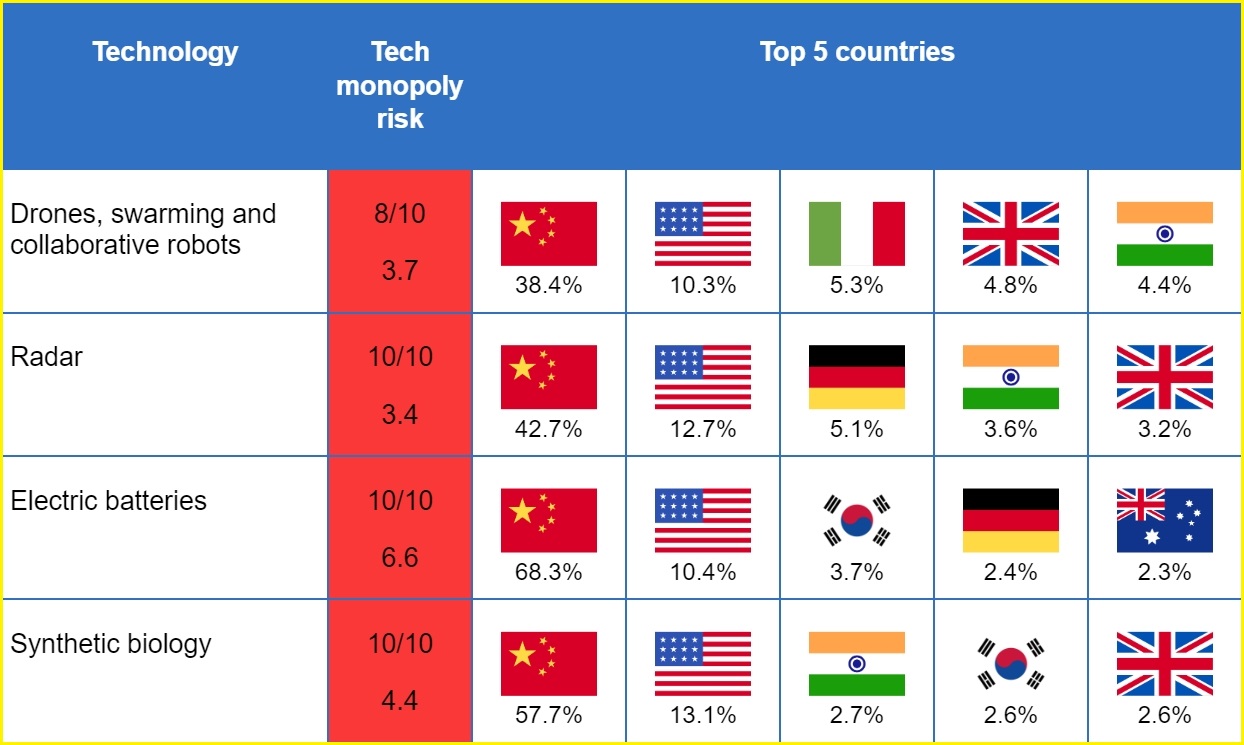China now leads the world in around 90 per cent of critical technology research and continues to extend its lead over the United States, according to a report by government-backed thinktank the Australian Strategic Policy Institute (ASPI).
The authors of the ASPI report, Jenny Wong-Leung, Stephan Robin and Danielle Cave, said China and the US had “effectively switched places” over the past two decades, with more research now taking place in large economies in the Indo-Pacific region “led by China’s exceptional gains”.
An update to ASPI’s Critical Technology Tracker found China — which led in only three of 64 technologies (5 per cent) between 2003 and 2007 — led in 57 of those areas (89 per cent) over the past five years.
The tracker ranks countries' competitiveness based on how often they are cited in the top 10 per cent of the most highly cited research papers in each category of innovation it tracks.
China was found to have achieved leadership in five new technologies since last year’s update: quantum sensors, high-performance computing, gravitational sensors, space launch and advanced integrated circuit design, and semiconductor fabrication.
The US, which led in 94 per cent of the tracked technologies between 2003 and 2007, led in only seven areas (11 per cent) in the past five years, including quantum computing, small satellites, atomic clocks, and natural language processing — a branch of artificial intelligence.
US technology companies such as Google, IBM, Microsoft, and Meta were found to have “leading or strong positions in AI, quantum and computing technologies”, but organisations including the National Aeronautics and Space Administration (NASA) and the US Air Force Research Laboratory slipped in the ratings, with all of the 10 top-performing institutions now in China.
The Chinese Academy of Sciences was the highest performing organisation overall, with a global lead in 31 of the 64 technologies (48 per cent).
"China has executed a dramatic step-up in research performance that other countries simply haven’t been able to match,” the authors wrote.
India has also emerged as “a key centre of global research innovation and excellence”, the researchers said, as the nation ranked in the top five countries for 45 of the 64 technologies (70 per cent), up from 37 last year.

Average annual research share across the 64 technologies between 2003 and 2023. Image: ASPI
China monopoly concerns
While only China and the US currently held the lead in any of the 64 tracked technologies, ASPI researchers said China was the lead country in 10 new areas which they now categorised as being at a high risk of becoming a one-nation monopoly.
"The number of technologies classified as ‘high risk’ has jumped from 14 technologies last year to 24 now,” they wrote.
“Worryingly, the technologies newly classified as high risk include many with defence applications, such as radar, advanced aircraft engines, drones, swarming and collaborative robots, and satellite positioning and navigation.”
The authors also noted that strong research performance did not mean China would necessarily have the same dominance in making those technologies a reality.
“At times, China is ahead in high impact research because it’s actually behind in the development and commercialisation of that technology and is making major investments to try to catch up to the advances made by other countries over previous decades,” they said.
The authors said it was possible that some US research in sensitive technologies had already moved “into classified or commercial-in-confidence spaces” but argued “other countries would be wise to assume” that China’s momentum would continue.
“Some observers might argue that China’s ascendance into a research power —indeed the research power — doesn’t matter because other countries, the US in particular, remain ahead in commercialisation, design and manufacturing.
“That might be true for some technologies, but it represents a very short-term attitude.
“China, too, is making enormous investments in its manufacturing capabilities, subsidising key industries and achieving technological breakthroughs that are catching the world by surprise.”
The US and Canada have made moves to protect their local economies from China’s manufacturing power, with both imposing 100 per cent tariffs on imports of Chinese electric vehicles.
China, meanwhile, has reportedly threatened Japan with economic retaliation if Tokyo further restricts sales and servicing of chipmaking equipment to Chinese companies.
 Image: ASPI
Image: ASPI
Australia improves in some areas, drops in others
The ASPI report found Australia had improved its research standing in some technologies over the past 21 years, but had slipped behind in others.
Australia now ranked in the top 10 countries for technologies such as AI, robotics, advanced materials and manufacturing, biotechnologies, and energy and the environment.
But the country had “slipped significantly” in all quantum technologies except for quantum sensors, biological manufacturing and some defence technologies such as autonomous underwater vehicles and satellite navigation, researchers said.
Australia was now in the top five countries in seven technologies, after ranking in the top five for nine technologies last year.
The report authors argued that AUKUS — the trilateral security partnership between Australia, the UK, and the US — was “on par with China” in some technologies such as adversarial AI, but still trailled China in areas including advanced robotics and autonomous systems.
"In some technologies, such as autonomous underwater vehicles and hypersonic detecting and tracking, China’s high-impact research lead is so pronounced that no combination of other countries can currently match it,” they said.
The authors said their findings were a reminder to governments that building technological capabilities required long-term investments.









